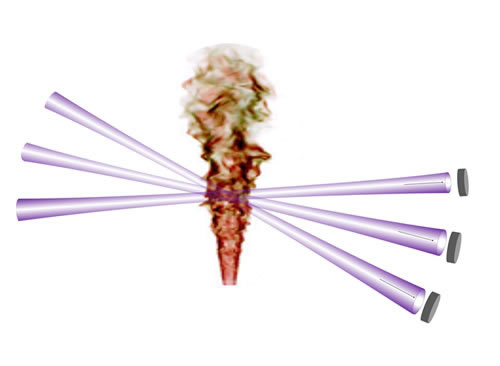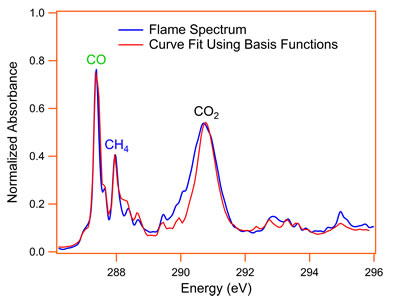Heterogeneous Chemical Reactions Combustion & Catalysis
Combustion is now and will remain for many decades the most important means of energy utilization by humankind. However, the benefits of modern combustion (e.g., reliable electricity, rapid transportation, heating, cooling, etc.), are accompanied by negative consequences such as harmful combustion particulates, photochemical smog, and anthropogenic climate change. A major challenge in establishing a science base for predictive models of engine combustion are the inherent inhomogeneities and correlations spanning a wide range of length- and timescales, and arising from the complex interrelationship of chemistry and turbulent fluid mechanics.


The fully coherent X-ray radiation from NGLS (delivered with high average power, high repetition rate, and user-selectable time/bandwidth) will enable a powerful new class of experimental methods for turbulent combustion: dynamic chemical imaging to reveal the fundamental chemistry and physics that govern the entire process of combustion, from fuel sprays to gas-phase combustion to particulate formation and evolution.. Cinematic, chemically specific macroscale imaging combines time-resolved X-ray fluorescence with tomographic imaging techniques to achieve dynamic 3-D chemical imaging at the µm spatial scales and µsec temporal scales that are important in combustion environments. These groundbreaking capabilities to chemically resolve spatiotemporal structures in the reacting flow of combustion will be instrumental in creating the science base for predictive combustion models.
Catalytic reactions are of vital importance in virtually all areas of energy generation: from industrial processing of fossil fuels, to reduction of harmful emissions from power plants and cars, to large-scale production of chemicals, to energy conversion and storage (e.g., fuel cells, artificial photosynthesis). NGLS will enable unique spectronanoscopy studies of catalysts in their working environment, with sub 10 nm spatial resolution, and femtosecond temporal resolution characteristic of electronic and nuclear motion in molecules. Chemically specific (resonant soft X-ray) coherent imaging techniques, and time-resolved ambient-pressure photoemission spectroscopy, will provide transformational insight to the specific elementary reaction steps as they proceed on heterogeneous catalysts. Such an understanding will facilitate the discovery of novel reaction pathways to make more selective (green chemistry) and more efficient (energy saving) catalysts.

